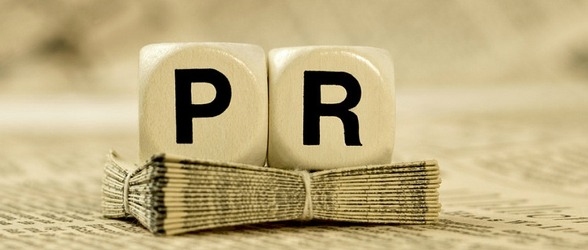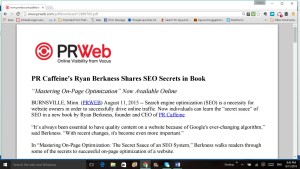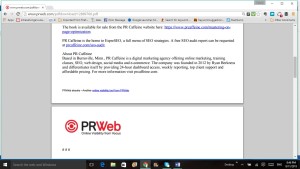The Guide to Press Releases for Ecommerce

If you’re like the vast majority of entrepreneurs, the idea of a press release has barely crossed your mind. I’ll let you in on a little secret.
You’re missing out.
Press releases, once the dominant way for businesses to gain a little media attention for their business, are strange creatures in digital marketing. My clients have asked hundreds of questions about press releases. I’m sure you share some of them.
Do these sound familiar: “Aren’t they worthless?”, “Do they do anything?”, “What does a good press release look like?”, “Why do my press releases always get rejected?”,
…and last, but my personal favorite, “What are they?” We’ll start by answering that one.
What are Press Releases?
When used properly, written well, and distributed in a timely manner, press releases are a great tool in any marketing campaign. A poorly written press release, on the other hand, is a waste of time, money, and energy.
The purpose of a press release is to make life easy for journalists while increasing the visibility of your brand. Consumers are more likely to buy from brands they are familiar with, so if you can get one of your press releases into the news, your sales are likely to improve. After all, customers will be more familiar with your brand. The better the press release, and the more appealing the content, the greater the likelihood that you’ll see an immediate return on your investment.
The rise of digital news media and blogging cut back on the impact of press releases – to an extent. Sponsored blog entries and brand journalism looked like they might kill off the need for press releases at one point, but then the press release adapted. Many press release services do more than just send your story out over the wire. They publish them on the web, too. A well-written press release that includes relevant keywords for your product can now raise the visibility of your brand, even if it never makes it into the news. That’s marketing gold, especially when you consider that many readers don’t discriminate between “the news” and the news-like presentation of press release websites like PR Newswire.
I get it. You still aren’t convinced. Let’s take a closer look at why press releases are a genius tool; the low-hanging fruit on the publicity tree. A well-done press release can do a lot to raise awareness of your brand, encourage sales, and build consumer confidence in your brand. There’s one main reason why. In a 1993 study, psychologist Daniel Gilbert discovered that people really do believe and make decisions based on what they read.
That makes a press release a very powerful tool.
Of course, you could argue that your company blog does an equally decent job, but you’re missing one key factor. Journalism is a profession that, as much as we tend to criticize it, is still considered to be a relatively objective source of information. A TRUSTED source.
What Does a Good Press Release Look Like?
Like quite a few professional writers who double as journalists, I’ve written press releases and also used them to help me craft news stories. My early press releases weren’t great. Trust me. It wasn’t until I sat on the other side of the news desk that I realized what was important, from the formula to follow to the tone, word count, and information to include.
Oh, and if you REALLY want your press release to get noticed, minimize the work the reporter has to do. If your release is already a news article, you’re in good shape. Most modern wire services do more than send your press release out over the wire. They publish your press release as an article on major internet news sites, add it to RSS feeds, may give you targeted PPC ads, and may even track its performance.
Not bad, right?
Notice a few things about that screenshot? All press releases need to include a clear, concise title between 65-80 characters in length for best results. A subtitle can be useful, too. After that, make sure to include your city and date, as well as the distribution service (if they don’t automatically fill in these blanks for you.
Short paragraphs are key, and you should lead with info that makes the release newsworthy and relevant for readers. Don’t forget to include a useful quote early on, too.
Next, include a quick to search list or our multimedia content. The screenshot above doesn’t show it, but this release also included a bullet point list and a picture of the book being released. Put your multimedia content in the middle of the release to keep readers and journalists hooked.
At the bottom of the release, include any relevant URLs and make sure that your boilerplate close is interesting and informative. Humor can be helpful here.
ALL press releases should end with “# # #” or “ends.”, but many services will include this automatically.
Not sure if you wrote a great release? Looking for a little extra help crafting one? This article on Kissmetrics does a great job explaining the mechanics of press releases, and how to make yours stand out.
Elements You NEED in Your Press Release
- Contact person
- Company contact info
- Your city
- Headline and subheading
- Lead paragraph
- 2-4 more paragraphs of factual, entertaining content
- Quotes
- Call to action
- Boilerplate closing
Little Extras That Make Big Impacts
Images. This is basic. Even if you don’t have the resources to include video or audio, you MUST use at least one photo. According to data on PR Newswire, this one simple change can increase engagement with your press release by 92%.
Multimedia. People love video content, and if you add other fun attributes like slide decks, interactive charts or graphs, or an audio clip, you’re more likely to see your press release in print or on TV, or hear it on air.
Data. Trust me, journalists love data. Statistics are a particularly welcome help, as is participant data from any studies.
Personally contact your media outlets of choice. If you have a media contact and you don’t use it, you’re a fool. And if you don’t have one and you don’t bother trying to make one, you’re next in line for that title…
Humor. Laughter sells, and encourages social sharing. If you think reporters are immune, think again. Most of them are still human.
Something really worth writing about. Forget the 7th anniversary of your company. Talk about how your product saved a puppy, changed someone’s life, or accomplished some unexpected and amazing feat. That’s what draws attention and gets journalists to write an article based on your release – not to mention the good karma it cultivates with the general public.
Things to Skip
Your press release shouldn’t focus on your company. Make it about the news item you are discussing, and make that relatable. Leave the jargon in the office, too. This piece will be read by the public in some cases, and in others, by journalists. Whoever tackles it, I can promise you that they won’t want to read it if they can’t understand it.
How Can You Leverage Press Releases in Your Business?
Now that you know what a good press release looks like, you need to know what to do with it. After all, what good is a press release if you only share it with your pet cat Fluffy?
Who Should Write It, and What Should It Cost?
If this is your first attempt at making the news, hire a pro. Most copywriters offer press release writing services, and there are several companies that specialize in this service, as well. Study what they do. Ask questions and educate yourself about the process. If you can’t afford a professional writer on a regular basis, this will at least give you a running start. Be upfront with your expectations, however, and make sure the writer knows that you want to handle this yourself in the future.
A well-written, professional press release will normally cost $400-700, although some press release services will write releases for you for much less, and marketing, public relations, or press release agencies may charge upwards of $7,500 based on factors including data collection, regulatory compliance, hours worked for their team, legal counsel, and SEO consultant input. That’s a hefty cost for small businesses.
How and Where to Submit Your Press Releases
Once upon a time, the only way to submit a press release was over the wire or directly to a contact you knew. Today, you’ve got a few more options. If your story is really newsworthy (be honest with yourself), send it to a journalist who specializes in covering your area of business. If time is short or you aren’t sure how to go about that, check out press release services. There are plenty of options, but Top SEOs ranks the following as the top 5 press release distribution services for August 2015, in order:
- 24-7pressrelease.com (Canada)
- com (USA)
- PR Newswire (UK)
- Business Wire (USA)
- eReleases (USA)
Realistically, the fee that these distribution services charge is worth every penny. Two services that didn’t make the Top SEOs list, but are definitely worth your time and money are Marketwired (formerly Marketwire) and PRWeb.
Too cheap or too broke to pay for distribution? There are free ways to get your press release out over the wire, but they may cost you in other ways. Their distribution is neither as complete nor as comprehensive, and their effects on your search rankings are hotly debated.
Mequoda.com put together a list of their favorite free press release distribution sites, and the following five made the cut. Notice that PR.com made the top 5 for Top SEOs, too. Newswire, which ranks 4th on the Mequoda list, was a runner up on Top SEOs’ list.
What to Expect from Your Press Releases
Keep in mind that this is a press release, not a miracle. Your expectations should be kept in check. That said, when used well, these tools can give your brand a publicity boost, help the public get to know your name, and improve sales and conversions. Measurement can be a challenge, but a quick search on how to measure the ROI on earned media should give you a good idea why a press release may or may not be a good pick for you.
Alternatives to Traditional Press Releases
Not sure you can commit to the price or process of creating a press release, or just not convinced that a press release is the right move in today’s PR world? The following options can easily help your business get ahead.
Help a Reporter Out (HARO)
If you’ve got time on your hands and don’t mind a wait, take a look at Help a Reporter Out. I turn to this site and the #HARO hashtag when I’m looking for a source, and many companies use it to raise their visibility. It’s a win-win for journalists and businesses, and best of all, it’s free.
Build Visible Expertise
Submitting articles to sites like Ezine can be one way to raise your profile, although keep in mind that while these sites were once very good at establishing expertise, their reputation isn’t so great as of late. The value and image of this type of site is dropping fast, so don’t invest much time or effort here.
Social Media Releases
The press release 2.0, also called the social media press release, is the next step for press releases. A way to enter the digital era, so to speak. Social media releases differ from traditional press releases on one major factor. Audience. These powerful PR tools cater to bloggers, journalists, and consumers – considerably expanding the reach of press releases.
One thing to consider carefully is distribution. You’ll need to connect with bloggers and journalists by email or social to share this release, and should definitely include the content on your own site. A few wire services for social exist, but they don’t follow the same model as traditional press release wire services, so consider them carefully. This article on Inc does a great job of explaining the basics, but keep in mind that it’s a little old – from 2010.
Blogger Briefings
A blogger briefing is a collection of online resources on a stable URL on your site that surround a particular topic. You can send the URL to bloggers who may be interested in your topic, as a way to make their research easier and give them access to accurate info that can be shaped into an article. This is like a press release in many ways, and you might consider posting it under any press release or media resource tabs on your site.
Get Personal
Do you really want to have your story covered in the press? Write a reporter who works in your area directly, but do so with tact. Reporters are flooded with requests a good portion of the time. It can be annoying if done wrong, but if you respect their time and keep your message brief, include newsworthy points, and don’t make yourself a pest, you can get a true newsworthy piece covered this way – assuming their editor approves.
That’s it. The press release is an easier beast to tackle than you thought. If you do have any questions or need any help, just let me know. I’m happy to help you out. Please take a second to share this list of press release tips, too. Someone out there is facing the same questions you had before you read this article. Give them a hand.
Tagged content marketing, press release distribution, press releases, trust signals, writing press releases







